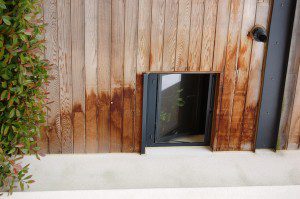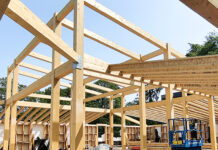
Knowing which wood is best for cladding and how to install it, is quite an art if the cladding is to perform and last. Exova BM TRADA’s Lewis Taylor discusses the key points to consider when choosing, specifying and installing timber cladding.
1) USE THE RIGHT SPECIES
The choice of timber species is normally based on aesthetics, durability and cost. Of these, the most important is durability, and assessing its class and performance is core to good specification.
The most common softwood species used for timber cladding include woods such as Western red cedar, larch, imported Douglas Fir, European Redwood and European Whitewood. Each of these has different durability. For instance, the Western red cedar can last for up to 30 years uncoated, where the Larch might only last for 15 – so knowing your wood’s durability is the first step to good cladding. Popular hardwoods for cladding are usually oak or sweet chestnut, but in deciding what to use, it is best to reference a robust database. The TRADA wood species database is a good place to start.
2) THINK ABOUT MOISTURE CONTENT
Understanding how timber moves in response to changes in moisture content is essential to ensure long life and good performance. One consideration is the width of the boards used. This is because by limiting board widths to a maximum of 150mm both the shrinkage and swelling remains manageable. Tongued and grooved boards need to be even narrower, with a maximum width of 125mm. This will reduce the risk of the tongues disengaging from the grooves when the boards shrink.
Where an open-jointed cladding system is used, water and light can penetrate to the substructure. It is therefore essential to give due consideration to waterproofing details around window and door openings, it may be necessary to apply a specialist UV-resistant breather membrane on the substructure itself.
3) USE THE RIGHT FIXINGS
Using stainless steel nails is highly recommended for softwood cladding, even if the cladding is to be painted.
The length of nails is also important. When using plain wire nails they should be long enough to achieve a point-side penetration of 2.5x the thickness of the cladding board into the support batten. So, for example, fixing a 20mm thickness board requires 50mm of nail penetration into the batten using nails of 70mm length.
Annular ring shank nails (sometimes called improved nails) only require point-side penetration of 2x the board thickness, and it is usual to use two nails at quarter points across the width of the board.
For hardwood cladding, installers usually use stainless steel screws to fix to the support battens, again using two fixings at quarter points across the board and pre-drilling holes slightly oversized to allow for shrinkage and expansion.
4) ENSURE GOOD SUPPORT BATTENS
Preservative-treated softwood cladding battens should be perpendicular to the cladding boards and depending on the board profile and installation method, vertical counter battens may be needed to provide drainage and ventilation. Horizontal battens should be chamfered to shed water.
5) REMEMBER VENTILATION
Maintaining good drainage and ventilation within the space behind the cladding is important. The purpose for this is to ensure durability, allow faster drying and to equalise moisture content on inner and outer faces.
Flashing details at the base of the cladding and around windows and doors should be designed to shed water away from the building while maintaining essential ventilation. Check the requirements for fire resistant cavity barriers with local building control and to consider using third-party approved, ventilated cavity barriers.
6) CONSIDER COATINGS
Before specifying coatings, it is wise to consider the anticipated service life of the coating and the required maintenance regime – many owners may be unaware of the importance of maintenance for durability and performance.
Clear coatings such as oils and varnishes will normally require pre-emptive re-application every year or so, meaning they are not a practical option. If the surface coating fails, leading to discolouration or weathering of the wood, simply reapplying the coating will not be sufficient as it will seal in the discolouration and trap moisture.
Paints and stains have a longer service life, though they do, of course, still require periodic re-application.
7) THE DEVIL IS IN THE DETAIL
There are design elements within cladding which can help avoid moisture traps and help with water management. Projections can create splashback, so cutting the ends of vertical cladding board to an angle will allow moisture to drip off. A gap of at least 8mm should also be used where end grains are exposed, such as in running joints or corner posts, to reduce the risk of water sitting against them.
8) USE PROPER INSTALLATION
Look after cladding boards before they are installed. Keeping boards spread out, well ventilated and loosely covered will reduce exposure to moisture and allow air flow, helping to minimise the risk of significant discolouration.
Optimum moisture content of timber cladding during installation should be maintained between 16% and 18% to reduce the likelihood of significant movement or distortion. Where surface coatings are used, they should be applied to all faces before fitting to avoid unfinished wood being exposed when the cladding swells or shrinks.
9) KEEP AN EYE ON WEATHERING
If the external timber cladding is to be left uncoated, it will always weather naturally and turn silver-grey over time, due to moisture and sunlight. Uncoated external timber cladding will always weather and this should be expected. It is not a good idea to use clear surface finishes to preserve colour as these require a high level of maintenance.
10) REDUCE THE RISK OF DISCOLOURATION
Extractive staining occurs when water soluble components in timber are brought to the surface but not washed away by rainwater. Timbers like oak and Western red cedar have high levels of extractives which will not wash away if the cladding is sheltered. If extractive staining occurs, it can be removed and the natural colour restored, or it can just be left to fade over time.










